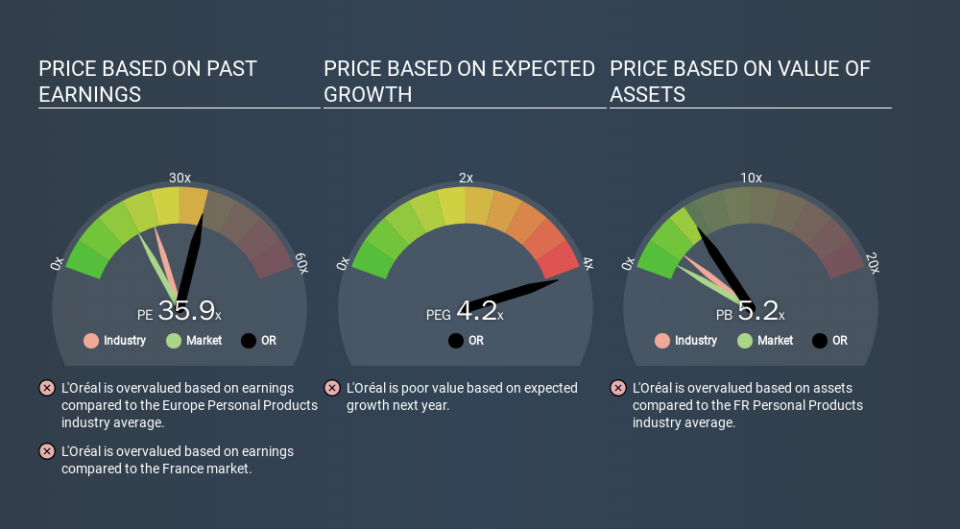What Does L'Oréal S.A.'s (EPA:OR) P/E Ratio Tell You?

Today, we'll introduce the concept of the P/E ratio for those who are learning about investing. To keep it practical, we'll show how L'Oréal S.A.'s (EPA:OR) P/E ratio could help you assess the value on offer. L'Oréal has a price to earnings ratio of 35.90, based on the last twelve months. In other words, at today's prices, investors are paying €35.90 for every €1 in prior year profit.
See our latest analysis for L'Oréal
How Do You Calculate L'Oréal's P/E Ratio?
The formula for P/E is:
Price to Earnings Ratio = Price per Share ÷ Earnings per Share (EPS)
Or for L'Oréal:
P/E of 35.90 = €253.10 ÷ €7.05 (Based on the trailing twelve months to June 2019.)
Is A High Price-to-Earnings Ratio Good?
A higher P/E ratio means that investors are paying a higher price for each €1 of company earnings. All else being equal, it's better to pay a low price -- but as Warren Buffett said, 'It's far better to buy a wonderful company at a fair price than a fair company at a wonderful price.
Does L'Oréal Have A Relatively High Or Low P/E For Its Industry?
We can get an indication of market expectations by looking at the P/E ratio. As you can see below, L'Oréal has a higher P/E than the average company (22.9) in the personal products industry.
That means that the market expects L'Oréal will outperform other companies in its industry. Shareholders are clearly optimistic, but the future is always uncertain. So investors should delve deeper. I like to check if company insiders have been buying or selling.
How Growth Rates Impact P/E Ratios
Earnings growth rates have a big influence on P/E ratios. When earnings grow, the 'E' increases, over time. And in that case, the P/E ratio itself will drop rather quickly. So while a stock may look expensive based on past earnings, it could be cheap based on future earnings.
L'Oréal's earnings per share fell by 2.1% in the last twelve months. But over the longer term (5 years) earnings per share have increased by 8.0%.
Remember: P/E Ratios Don't Consider The Balance Sheet
The 'Price' in P/E reflects the market capitalization of the company. In other words, it does not consider any debt or cash that the company may have on the balance sheet. The exact same company would hypothetically deserve a higher P/E ratio if it had a strong balance sheet, than if it had a weak one with lots of debt, because a cashed up company can spend on growth.
While growth expenditure doesn't always pay off, the point is that it is a good option to have; but one that the P/E ratio ignores.
Is Debt Impacting L'Oréal's P/E?
Since L'Oréal holds net cash of €2.4b, it can spend on growth, justifying a higher P/E ratio than otherwise.
The Verdict On L'Oréal's P/E Ratio
L'Oréal has a P/E of 35.9. That's higher than the average in its market, which is 17.8. The recent drop in earnings per share would make some investors cautious, but the healthy balance sheet means the company retains potential for future growth. If fails to eventuate, the current high P/E could prove to be temporary, as the share price falls.
Investors should be looking to buy stocks that the market is wrong about. As value investor Benjamin Graham famously said, 'In the short run, the market is a voting machine but in the long run, it is a weighing machine. So this free visual report on analyst forecasts could hold the key to an excellent investment decision.
Of course, you might find a fantastic investment by looking at a few good candidates. So take a peek at this free list of companies with modest (or no) debt, trading on a P/E below 20.
If you spot an error that warrants correction, please contact the editor at editorial-team@simplywallst.com. This article by Simply Wall St is general in nature. It does not constitute a recommendation to buy or sell any stock, and does not take account of your objectives, or your financial situation. Simply Wall St has no position in the stocks mentioned.
We aim to bring you long-term focused research analysis driven by fundamental data. Note that our analysis may not factor in the latest price-sensitive company announcements or qualitative material. Thank you for reading.

 Yahoo Finance
Yahoo Finance 
